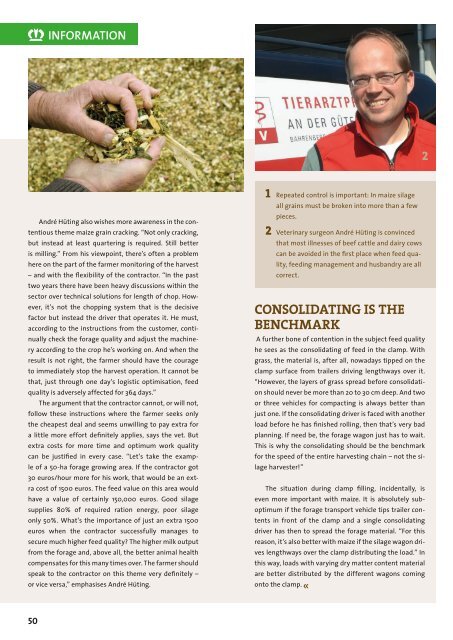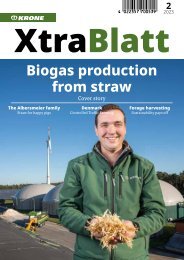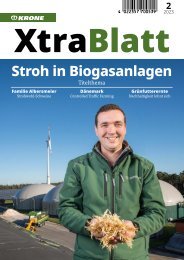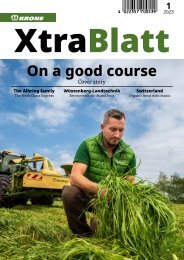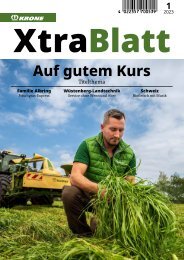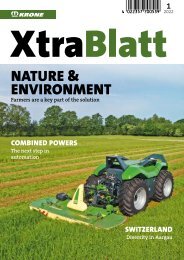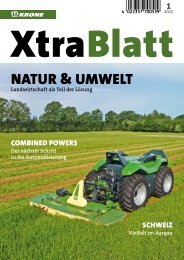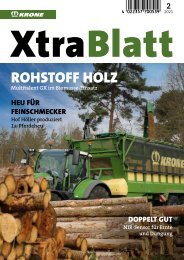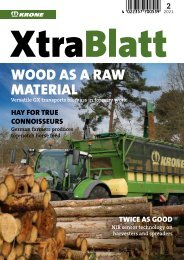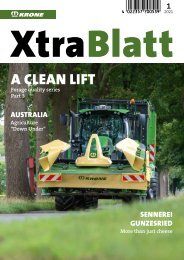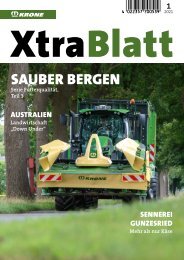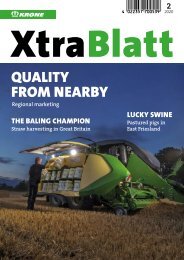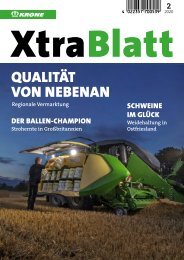XtraBlatt Issue 02-2017
You also want an ePaper? Increase the reach of your titles
YUMPU automatically turns print PDFs into web optimized ePapers that Google loves.
MENSCHEN INFORMATION<br />
2<br />
1<br />
1 Repeated control is important: In maize silage<br />
all grains must be broken into more than a few<br />
André Hüting also wishes more awareness in the contentious<br />
theme maize grain cracking. “Not only cracking,<br />
but instead at least quartering is required. Still better<br />
is milling.” From his viewpoint, there’s often a problem<br />
here on the part of the farmer monitoring of the harvest<br />
– and with the flexibility of the contractor. “In the past<br />
two years there have been heavy discussions within the<br />
sector over technical solutions for length of chop. However,<br />
it’s not the chopping system that is the decisive<br />
factor but instead the driver that operates it. He must,<br />
according to the instructions from the customer, continually<br />
check the forage quality and adjust the machinery<br />
according to the crop he’s working on. And when the<br />
result is not right, the farmer should have the courage<br />
to immediately stop the harvest operation. It cannot be<br />
that, just through one day’s logistic optimisation, feed<br />
quality is adversely affected for 364 days.”<br />
The argument that the contractor cannot, or will not,<br />
follow these instructions where the farmer seeks only<br />
the cheapest deal and seems unwilling to pay extra for<br />
a little more effort definitely applies, says the vet. But<br />
extra costs for more time and optimum work quality<br />
can be justified in every case. “Let’s take the example<br />
of a 50-ha forage growing area. If the contractor got<br />
30 euros/hour more for his work, that would be an extra<br />
cost of 1500 euros. The feed value on this area would<br />
have a value of certainly 150,000 euros. Good silage<br />
supplies 80% of required ration energy, poor silage<br />
only 50%. What’s the importance of just an extra 1500<br />
euros when the contractor successfully manages to<br />
secure much higher feed quality? The higher milk output<br />
from the forage and, above all, the better animal health<br />
compensates for this many times over. The farmer should<br />
speak to the contractor on this theme very definitely –<br />
or vice versa,” emphasises André Hüting.<br />
pieces.<br />
2 Veterinary surgeon André Hüting is convinced<br />
that most illnesses of beef cattle and dairy cows<br />
can be avoided in the first place when feed quality,<br />
feeding management and husbandry are all<br />
correct.<br />
CONSOLIDATING IS THE<br />
BENCHMARK<br />
A further bone of contention in the subject feed quality<br />
he sees as the consolidating of feed in the clamp. With<br />
grass, the material is, after all, nowadays tipped on the<br />
clamp surface from trailers driving lengthways over it.<br />
“However, the layers of grass spread before consolidation<br />
should never be more than 20 to 30 cm deep. And two<br />
or three vehicles for compacting is always better than<br />
just one. If the consolidating driver is faced with another<br />
load before he has finished rolling, then that’s very bad<br />
planning. If need be, the forage wagon just has to wait.<br />
This is why the consolidating should be the benchmark<br />
for the speed of the entire harvesting chain – not the silage<br />
harvester!”<br />
The situation during clamp filling, incidentally, is<br />
even more important with maize. It is absolutely suboptimum<br />
if the forage transport vehicle tips trailer contents<br />
in front of the clamp and a single consolidating<br />
driver has then to spread the forage material. “For this<br />
reason, it’s also better with maize if the silage wagon drives<br />
lengthways over the clamp distributing the load.” In<br />
this way, loads with varying dry matter content material<br />
are better distributed by the different wagons coming<br />
onto the clamp.<br />
50


